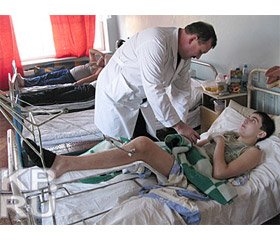Журнал «Травма» Том 16, №1, 2015
Вернуться к номеру
Clinical and nosological structure of long bones injuries of victims due to the traffic accidents
Авторы: Guryev S.O., Yevdoshenko V.P., Satsyk S.P. - State Institution «Ukrainian scientific and practical center of emergency medical care and disaster medicine of Ministry of Healthcare of Ukraine», Kyiv, Ukraine
Рубрики: Травматология и ортопедия
Разделы: Клинические исследования
Версия для печати
Introduction. Extremely importent over the last decades in Ukraine and in the world, has been the problem of severe mechanical injuries, which had occurred due to the traffic accidents. As the part of severe injuries one of the leading ranks take the skeletal injuries, including fractures of long bones. These fractures account from 48% to 70% of all skeletal bones injuries. Such situation had made a huge presure on the organizations of the health care and this problem remains extremely relevant in our days.
Materials and methods. We had investigated 139 cases of long bone injuries with polytrauma of victims due to traffic accident which were treated in Sumy’s city hospital number 1 in the period from 2008 to 2011 Among this cases were – male 86 (61,87%), female – 53 (38,13%). On the basis of participation in the traffic, they were divided into: pedestrians – 81 (58,27%) drivers of 2 wheeled vehicles – 22 (15,83%), passengers of 4 wheeled vehicles – 20 (14.39%) drivers of 4 wheeled vehicles – 11 (7,91%), passenger of 2 wheeled vehicles – 5 (3,6%). In general, passive members of the traffic (pedestrians and passengers) were 76,26% and the active members of the traffic (drivers) – 23,74%. Mortality in the studied group was 16,55%.
Results. It had been established that the injuries of long bones was combined with head injuries in 60,21% cases, with chest in 11,74%, abdomen – 8,67%, pelvis – 4,59%, spine in 3,06%, neck 1,53%. Multiple limbs injuries was 10,20%. The injuries of the long bones in the lower extremities were 56,84% of the upper extremities – 23,02%, upper and lower extremities – 20,14%. Right-side injuries amounted about 43,17%, left-side injuries – 39,57%, and bilateral injuries – 17,26%. Injuries of the tibia was observed in 30,2%, fibula – 25,09%, the femur – 18,04%, the humerus – 14,9% radius – 7,06%, ulna – 4, 71%. The ratio of combination of long bone injuries in the group of survived was 1,71, in the group of died – 2.48, the total array of research – 1.83. Simple injuries were observed in 16,08%, 76,47% – clastic injuriess, 7,45% – much clastic injuries. The injuries of individual segments of long bones was characterized by its variability, but in general array the research was almost identical: the proximal segment 33,11%, 32,76% – diaphyseal segment, and distal segment 34,13%. In 12,97% of cases were observed the injuries of two, usually adjacent, segments.
In case of the humerus injured the proximal segment injuries was 56,82%, diaphyseal segment – 15,91%, distal segment – 27,27%. In case of the radius injured the proximal segment injuries was at 26,32%, diaphyseal segment – 31,58%, distal segment – 42,1%. In case of the ulna injured the proximal segment injuries was in 46,15%, of diaphyseal segment – 38,46%, distal segment – 15,39%. In case of the femoral injured the proximal segment injuries was– 38,46% of diaphyseal segment – 28,85%, distal segment – 32,69%. In case of the tibia injured the proximal segment injuries was 26,67%, diaphyseal segment – 38,89%, distal segment – 34,44%. In case of the fibula injured the proximal segment injuries was 22,67%, diaphyseal segment – 37,33%, distal segment – 40%. The credible difference of segments injuries of long bones in studied groups hadn’t been found.
Conclusions. 1. The injuries of the long bones with polytrauma due to traffic accidents most often combined with head injuries in 60,21% of victims. Multiple limbs injuries was 10,20%.
2. The injuries of the tibia was observed in 30,2%, fibula – 25,09%, the femur – 18,04%, the humerus – 14,9% radius – 7,06%, ulna – 4, 71%. In 16,08% of the group were observed simple injuries, 76,47% – clastic injuriess, 7,45% – much clastic injuries. The injuries of individual segments of long bones was characterized by its variability, but in general array the research was almost identical.
3. The problem of long bone injuries of victims with polytrauma due to traffic accidents is significant in traumatology. The issues of medical care and treatment need further researches, without which it is difficult to expect the decrease of mortality.

